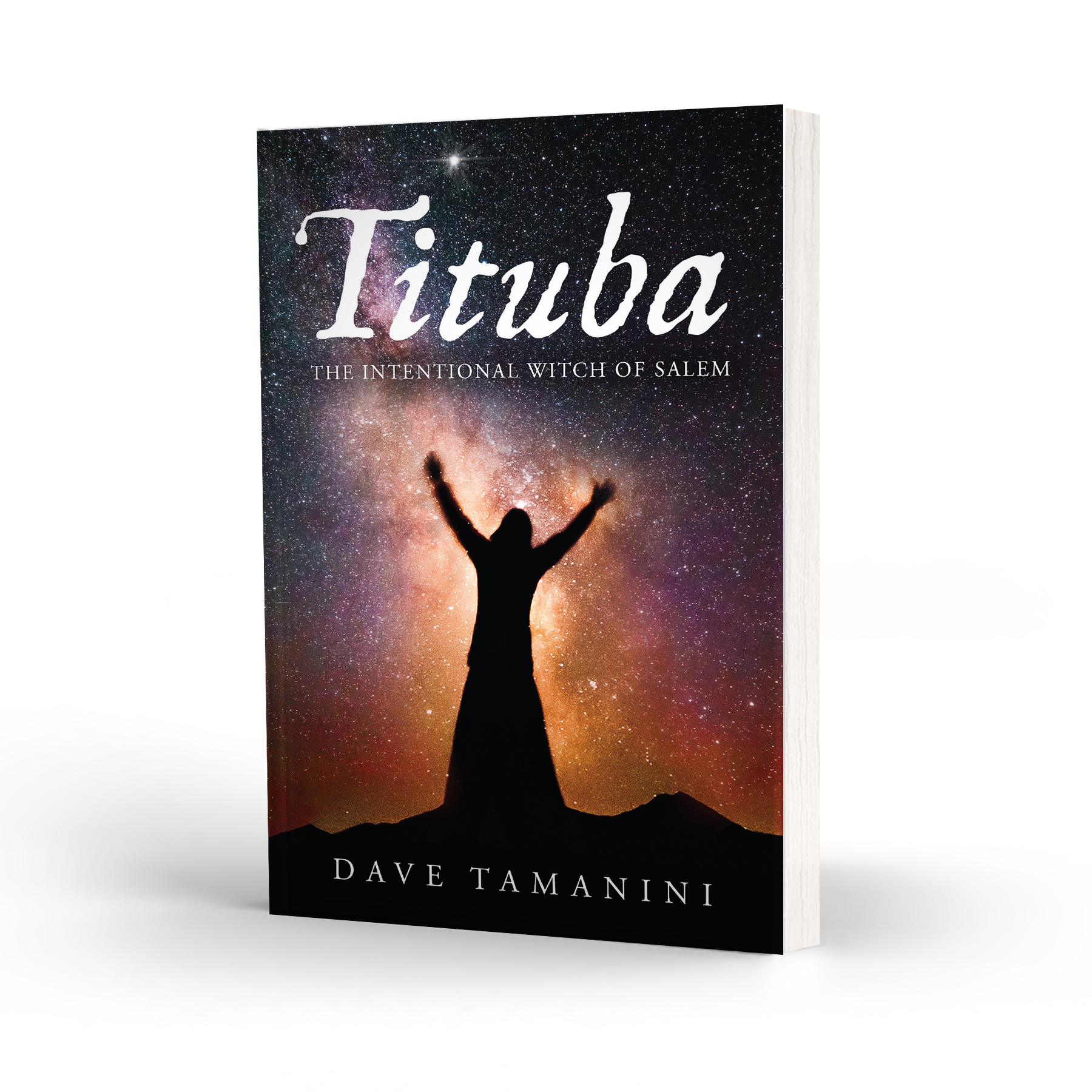A Visit With Dave Tamanini
book NG: Hi Dave, I’m delighted to talk to you about your award-winning novel, Tituba: The Intentional Witch of Salem.
DT: Hi, Nancy, and hello to your readers. Thank you for inviting me.
NG: In a bit of serendipity, I recently interviewed Rachel Christ, Education Director at the Salem Witch Museum. She enjoyed your book so much that the museum now offers it at their bookstore. Did you research your book in Salem? Tell us about what you learned.
DT: Rachel Christ has done a lot of terrific work at the Salem Witch Museum. I was happy she enjoyed the book, and, of course, I’m thrilled they are now carrying Tituba in their bookstore.
I spent four years overall in research about the Puritans of Salem and their daily physical and emotional struggles. And I discovered how their strict religious doctrine played a major role in their slide into the witch accusations of 1692.
The research was lots of fun since I knew little about that era, much less the actual witch accusations and court hearings. I started digging with the internet where all things seem to start. I dug into books by historians and transcripts from the court records before my first actual visit to the region, starting in Danvers, MA.
Back in the day, present-day Danvers was Salem Village. Salem Village’s parsonage is where the first accusations arose after members of the household were said to be attacked by witches. I visited the archeological remains of the parsonage where Tituba lived as an enslaved woman, and it is the center for most of the story. There is something special about location visits. I got to see examples of old buildings in the area. The Rebecca Nurse Home is a museum of daily life. It also has a walk-through reproduction of the meeting house where some hearings occurred. These and many other places helped me enrich the story’s 17th-century colonial setting.
NG: Magic empowered your fictionalized version of Tituba. Your terrific book trailer is available on YouTube: https://www.youtube.com/watch?v=P8sKUOVcbg4
What inspired you to add an element of magic to your story?
DT: I had been casting about for a story involving magic, and, by chance, I attended a legal seminar about 1692 and the sordid history of witch trials. It astonished me to learn the colonists, ministers and jurists permitted what they called spectral evidence in the hearings. These were mere mentions that an accuser saw the accused do a witch-like thing.
To me, using spectral evidence was magical thinking. And it led to the convictions and hanging of nineteen innocent people.
Tituba was the first person accused of witchcraft, and she then accused others of being witches. Her claims instigated more fears of invasion by the Devil’s helpers and more accusations. So, I wondered, what if she had magical powers and what if something terrible incited her use of her magic? The answer was “Tituba: The Intentional Witch of Salem!”
NG: I was touched by a recent interview you gave when you noted that many of the descendants of the 1692 witch trials, both accused and accusers, often take pride in their ancestry. But because Tituba disappeared into history, her descendants can make no such claim. Is that what motivated you to write your fictionalized account of her story?
DT: Yes, that added to the pathos of her actual life and inspired me to build a story about her. After they arrested Tituba for witchcraft, she spent more than a year in filthy jails. She was chained to the walls like the others, so they could not fly off to do mischief.
When the hysteria ended by a decree of the governor, Rev. Parris would not pay her prison bills to reclaim her, and she remained in jail before leaving under unknown circumstances. There is no death record, nor children, or descendants to remember her.
As an enslaved woman living without agency, I didn’t want her to disappear again as a powerless person. So, after I created agency for her, which she abused horribly, she had to face what she’d done. The story ends when she confronts her guilt and sees the choices she must make to survive.
NG: In your novel, Tituba is married to a Native American slave named Skitôp and has a son named Akanni. Are those characters real or from your imagination?
DT: Historical Tituba and John Indian, and an unnamed “negro boy” about fourteen years old, were brought to Boston and then Salem by Reverend Parris. John Indian’s origins like Tituba’s are also unconfirmed. I theorized that John Indian could have been a Pequot tribesman. In the story, young Tituba hears him defiantly tell a white man in his native language “I am Skitôp,” meaning, “I am a man.” From then on, Tituba called her beloved by this endearment.
The fourteen-year-old that accompanied them, I characterized as the child of Tituba and Skitôp. Tituba named him Akanni, which in the Yoruba language means “The first one.”
As for the meaning of Tituba’s name, well… I’ll leave that for readers to discover!
NG: Your family came from the northeastern coal region of Pennsylvania, and you grew up in a U.S. Army family. You’ve worked as a civil rights investigator for race and gender discrimination and as a general practice lawyer. You’ve said that your background taught you a lot about human strength, frailty… and hypocrisy. How does that influence your writing?
DT: You see all kinds of folks in the military, and we moved frequently. As a result, I was exposed to diverse people even before I understood a lot about them. In the law, I represented diverse people, too. I saw human frailty and strength on both sides as parties struggled with each other. And sometimes hypocrisy raised its head among them or their lawyers.
The best writers say a story must have conflict running from beginning to end; both a character’s internal conflict and external conflict like one person vs another person, or against nature or against themselves. And I think my experience in life helps me tell more than just what happens, but to reproduce the feelings of my characters and their character traits when they are caught up in conflict.
NG: Do you have plans for future books?
DT: Yes, I’m currently working on short stories before committing to another novel. The truth of the matter is a newly published author like me has to devote a lot of time to getting the word out about the book. And that takes up writing time.
NG: Is there a question you wished I’d asked?
DT: Hmm I’ll have to think about that and get back to you! But seriously, thanks again for having me. And let me say to everyone. Get your Covid-19 vaccine shots as soon as you can and be careful out there!
NG: Dave’s book can be purchased at any good bookstore and will be available in many libraries as of April 1, 2021. If you have questions or comments, or wish to sign up for his newsletter, contact Dave at: https://www.davetamaniniauthor.com/





Lovely interview! I am looking forward to reading this book, and I’m interested in learning more about the witch trials from this perspective. There is something horrifically fascinating about this part of our New England history.
Glad you enjoyed the interview, Shelley. Thanks for commenting 🙂
Nancy
Very interesting interview, Nancy.
So much, I didn’t (and still don’t) know about Salem and the Witch Trials; didn’t realize that Danvers was originally Salem Village.
Thank you for sharing.
Thanks, Jim. I remember the time you and Lynda and David and I visited Salem. A fun visit!!!
I agree with Jim (I always do). I learned things I didn’t know about Salem.